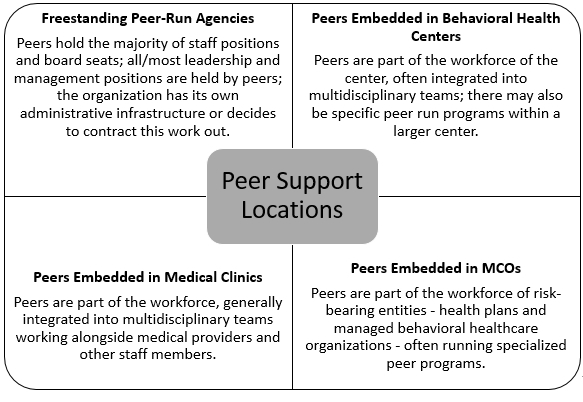It Takes a Village
Peer, Family and Community Support -> Behavioral Health Peer SupportBehavioral Health Peer Support
Individuals with lived experience of recovery from mental illness and/or addiction and others committed to improving the system of care for persons with behavioral health disorders have been actively building system designs that describe a behavioral health peer support framework. This section of the E-Guide describes five essential elements of this emerging framework:
- Peer Support Core Values
- Peer Support Service Locations
- Peer to Peer Program Models
- Type of Social Support and Associated Peer Recovery Support Services
- Peer Support Specialist Roles
Peer Support Core Values
The following core values have been ratified by peer supporters across the country:
| · Peer support is voluntary
· Peer supporters are hopeful · Peer supports are open minded · Peer supporters are empathetic · Peer supports are respectful · Peer supporters facilitate change |
· Peer supporters are honest and direct
· Peer support is mutual and reciprocal · Peer support is equally shared power · Peer support is strengths-focused · Peer support is transparent · Peer support is person-driven |
(Source: National Practice Guidelines for Peer Supporters; 2011.)
Peer Support Service Locations
Currently, there are four main locations where peer support services are sited. Note that peers often work in the community, regardless of their home base.
Peer to Peer Program Models
The US Department of Defense has identified four models of peer-to-peer programs that are relevant to the entire field.
| Model | Description | Strengths | Limitations |
| Support Group | Multiple individuals meet to share experiences | Opportunities to learn from others’ experiences and more opportunities to strengthen social network | Can be difficult to start, requires administrative support and multiple individuals |
| Peer Mentor | Mentor meets with an individual one-on-one | Individual attention and advocacy | Dependent on the abilities of the peer mentor |
| Community Health Worker | Liaison between a population and health care providers; not always a true peer | Ability to build a bridge between health care providers and individuals not already in care | Peers may be absorbed into health care provider system and lose peer qualities |
| Peer Educator | Educational course with discussion time | Access to information, recognition that there are others in the same situation | Short-term intervention; does not provide ongoing support |
(Source: US DOD Defense Centers of Excellence for Psychological Health & Traumatic Brain Injury; 2011.)
Type of Social Support and Associated Peer Recovery Support Services
| Type of Support | Description | Peer Support Service Example |
| Emotional | Demonstrate empathy, caring, or concern to bolster person’s self-esteem and confidence. | Peer mentoring
Peer-led support groups |
| Informational | Share knowledge and information and/or provide life or vocational skills training. | Parenting class
Job readiness training Wellness seminar |
| Instrumental | Provide concrete assistance to help others accomplish tasks. | Child care
Transportation Help accessing community health and social services |
| Affiliational | Facilitate contacts with other people to promote learning of social and recreational skills, create community, and acquire a sense of belonging. | Recovery centers
Sports league participation Alcohol and drug-free socialization opportunities |
(Source: SAMHSA Center for Substance Abuse Treatment; 2009.)
Peer Support Specialist Roles
- Help peers create individual service plans based on recovery goals and steps to achieve those goals
- Use recovery-oriented tools to help their peers address challenges
- Assist others to build their own self-directed wellness plans
- Support peers in their decision-making
- Set up and sustain peer self-help and educational groups
- Offer a sounding board and a shoulder to lean on
- Advocate with individuals for what they need
- Work within integrated health settings
- Support people in crisis
- Share their personal stories of recovery
(Source: DBSA; 2014. Jorgenson, J. Smoock, A.; 2014.)

